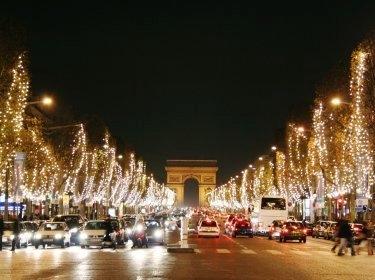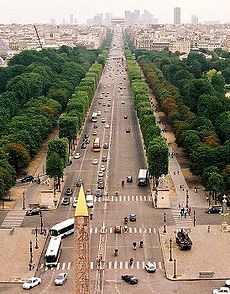Aidan Curran posted on March 11, 2009 19:00
The French, not noted for false modesty, call it
“la plus belle avenue du monde” – the most beautiful avenue in the world. Around Christmas when it’s strung with lights from top to bottom, or in springtime when the sun shines, you could well believe it. Parisians, however, tend to steer clear of the place. (Similarly, a true Parisian has never gone up the
Eiffel Tower unless dragged there by foreign guests.) It’s not even in the centre of the city but towards its western edge, close to Porte Maillot where the Irish get the airport bus to Beauvais.

But for the rest of the world, the Avenue des Champs-Élysées (to give it its full name) is synonymous with Parisian glamour and French culture. Which is true, up to a point. Until the mid-19th century a few peasant hovels still lined the street; some Parisians see its souvenir stores and fast-food joints and maintain that this remains the case.
Yes, going downhill literally if not figuratively, the left side is thronged with tourists taking photos, buying trinket souvenirs and refuelling in overpriced restaurants. (The Champs-Élysées is not a place to go for food, unless you can afford to eat in
Fouquet’s.) Down the less-crowded right you have your wealthier visitors flouncing into flagship designer stores like
Louis Vuitton, now one of the main tourist attractions in Paris (especially for American R n’B divas, we hear). On Saturday nights and the wee hours of Sunday morning it’s the busiest street in Paris, as its nearby nightclubs fill and empty while fleets of taxis set down and pick up.
But what makes the Champs-Élysées wonderful is its sense of history. After all, it runs from the Arc de Triomphe down to Place de la Concorde. And halfway down there’s the large statue of a true French giant, Charles de Gaulle, to commemorate his triumphant march down the newly-liberated avenue on 26 August 1944. In Greek mythology the Elysian Fields were the home of the blessed, but across the street from
le grand Charles a man of lesser stature currently resides in the Palais d’Élysées, official residence of the President of France. Every 14 July he reviews a military parade along the avenue to mark
the French national holiday.
Of course, foreign leaders have led troops down the Champs-Élysées, and not usually to celebrate the glory of France. But we’ll skip over that for the time being.
If you visit Paris you should make your own little victory march down the Champs-Élysées. A sunny Sunday afternoon is the best time. Start at the top with the Arc de Triomphe and go down the right-hand side, where there are less people. We recommend that you stop for coffee and
macarons in the
Ladurée tea-room, where you have a great view onto the avenue. Visit Louis Vuitton if you like, of course, but if you want to buy music as your Champs-Élysées souvenir you can pop across the street to Virgin or
FNAC, both of which are open every night until midnight. (Alternatively, the souvenir shops sell cheap Paris-themed compilations that feature out-of-copyright recordings of
Edith Piaf, Josephine Baker, Charles Trenet and the like.)

Halfway down, the buildings end and the Champs-Élysées becomes a park-lined avenue, an arena for strolling. The richer of you will turn right onto Avenue Montaigne and its exclusive boutiques, but if you continue down the Champs you’ll see the impressive glass roof of the
Grand Palais exhibition hall beside the statue of de Gaulle. Then at the bottom of the avenue you’ll reach Place de la Concorde (formerly home to the French Revolution’s most infamous guillotine, where Sydney Carton does his ‘far far better thing’ at the end of ‘A Tale of Two Cities’), the Tuileries and the Louvre.
Musically, the Champs-Élysées area is associated with can-can cabarets like the
Lido and exclusive nightclubs like Regine's and the Queen. But there’s no concert venue here; just a couple of overpriced music bars on adjoining streets. Considering its popularity as a public gathering-place, it’s surprising that there doesn’t ever seem to have been a large open-air show on the Champs-Élysées. (The now-traditional 14 July free concert is held on the Champs de Mars, under the Eiffel Tower. And
Jean-Michel Jarre, king of record-breaking concert crowds, held his giant 1990 Paris show at nearby La Défense.)
But there is one French song associated with la plus belle avenue du monde. Many French people immediately think of it when they visit the street for the first time – some even burst into its earworm chorus. (Sing it to any Frenchperson you meet and see what reaction you get.)
The song is called ‘Aux Champs-Élysées’ and it was made famous by a ‘70s cabaret singer called Joe Dassin, son of renowned director Jules Dassin who made
'Rififi' and its much-imitated break-in sequence. Your blogger first heard it in our French evening class back in Dublin, just before The Great Leap Forward and moving to Paris. The song has gained slight cult status from being on the soundtrack to Wes Anderson’s
‘The Darjeeling Limited’ but it’s still utter cheese – and what could be more French than that?
More ...
[Read More...]